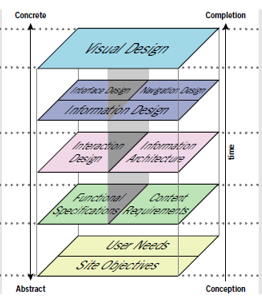Continuing our series on User Experience, (UX) this post will explore the concept of Information Architecture – what it is and how it is a necessary component of good UX design.
For what it’s worth, the term “information architect” is credited to Richard Saul Wurman and dates back to 1976. Once the World Wide Web came on the scene, other people began to work with information on the web and began speaking and writing about Information Architecture as a discipline. Something that impacted my understanding of Information Architecture early in my technology career was a conceptual model/diagram created by Jesse James Garrett, author of The Elements of User Experience (great book by the way…very practical with lots of keen insight).
In Jesse’s own words, the “goal of this document is to define some of these terms within their appropriate contexts, and to clarify the underlying relationships among these various elements.” As I studied Jesse’s conceptual model of the web and web applications, it became clear to me that Information Architecture is not business analysis, visual design or interaction design (nor is it many of the other things I’ve heard people say it is). Rather, Information Architecture is all about structuring information so that it is easy accessible.
The definition that I’ve landed on, which is really a slight modification of the definitions I’ve encountered as I’ve studied Information Architecture over the years is this:
Information Architecture: Organizing information and creating solutions (browse and search) to facilitate intuitive access to content.
Information Architecture is all about findability. If what you are doing does not affect findability, then it’s not Information Architecture. If what you’re doing affects findability, then it is Information Architecture. For the purists, yes…there’s a little gray area with Information Architecture. Some of those gray areas include certain elements of information design, interface design, navigation design and likely other areas of web design. Those areas used to slow me down; not anymore. The core of IA is not gray (findability) and I run with that, providing my clients with intuitive solutions that will help their users quickly find the information they need so they can be productive.
There’s a lot more I could share about what Peter Morville and Louis Rosenfeld, authors of the landmark book Information Architecture for the World Wide Web (O’Reilly Media, Inc. 1998) have said, as well as others who have contributed to the discipline of Information Architecture and its definition, but I really wanted to share with the readers Jesse’s conceptual model. The model makes good sense and it can be well understood in 15 minutes.
“Ok,” you say, “so Information Architecture really is a specific discipline within web based information systems? Why should I care?” The answer: Information doesn’t organize itself…and poorly organized information can be costly. Stay tuned for the next article in this series entitled Information Architecture – Why should I care?


